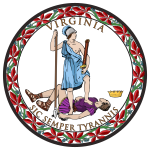| Elections in Virginia |
|---|
 |
Virginia elected its members in April 1807, after the Congress began but before the first session met.
| District | Incumbent | Party | First elected | Result | Candidates |
|---|---|---|---|---|---|
| Virginia 1 | John G. Jackson | Democratic-Republican | 1803 | Incumbent re-elected. | √ John G. Jackson (Democratic-Republican) 58.9% Noah Linsley (Federalist) 41.1% |
| Virginia 2 | John Morrow | Democratic-Republican | 1805 | Incumbent re-elected. | √ John Morrow (Democratic-Republican) Unopposed |
| Virginia 3 | John Smith | Democratic-Republican | 1801 | Incumbent re-elected. | √ John Smith (Democratic-Republican) [lower-alpha 1] James Singleton |
| Virginia 4 | David Holmes | Democratic-Republican | 1797 | Incumbent re-elected. | √ David Holmes (Democratic-Republican) Unopposed |
| Virginia 5 | Alexander Wilson | Democratic-Republican | 1804 (Special) | Incumbent re-elected. | √ Alexander Wilson (Democratic-Republican) 57.0% Oliver Towles (Democratic-Republican) 23.4% Robert Bailey (Quid) 19.3% |
| Virginia 6 | Abram Trigg | Democratic-Republican | 1797 | Incumbent re-elected. | √ Abram Trigg (Democratic-Republican) [lower-alpha 1] Daniel Sheffey (Quid) |
| Virginia 7 | Joseph Lewis Jr. | Federalist | 1803 | Incumbent re-elected. | √ Joseph Lewis Jr. (Federalist) 55.2% John Littlejohn (Democratic-Republican) 44.8% |
| Virginia 8 | Walter Jones | Democratic-Republican | 1803 | Incumbent re-elected. | √ Walter Jones (Democratic-Republican) 86.7% Richard Barnes (Federalist) 13.3% |
| Virginia 9 | Philip R. Thompson | Democratic-Republican | 1793 | Incumbent lost re-election. New member elected. Democratic-Republican hold. | √ John Love (Democratic-Republican) 60.5% Philip R. Thompson (Democratic-Republican) 39.5% |
| Virginia 10 | John Dawson | Democratic-Republican | 1797 | Incumbent re-elected. | √ John Dawson (Democratic-Republican) 60.0% John Mercer (Democratic-Republican) 40.0% |
| Virginia 11 | James M. Garnett | Democratic-Republican | 1805 | Incumbent re-elected. | √ James M. Garnett (Democratic-Republican) 63.2% Larkin Smith (Democratic-Republican) 36.8% |
| Virginia 12 | Burwell Bassett | Democratic-Republican | 1805 | Incumbent re-elected. | √ Burwell Bassett (Democratic-Republican) Unopposed |
| Virginia 13 | William A. Burwell | Democratic-Republican | 1806 (Special) | Incumbent re-elected. | √ William A. Burwell (Democratic-Republican) Unopposed |
| Virginia 14 | Matthew Clay | Democratic-Republican | 1797 | Incumbent re-elected. | √ Matthew Clay (Democratic-Republican) 99.5% |
| Virginia 15 | John Randolph | Democratic-Republican | 1799 | Incumbent re-elected. | √ John Randolph (Democratic-Republican) Unopposed |
| Virginia 16 | John W. Eppes | Democratic-Republican | 1803 | Incumbent re-elected. | √ John W. Eppes (Democratic-Republican) Unopposed |
| Virginia 17 | John Claiborne | Democratic-Republican | 1805 | Incumbent re-elected. | √ John Claiborne (Democratic-Republican) Unopposed |
| Virginia 18 | Peterson Goodwyn | Democratic-Republican | 1803 | Incumbent re-elected. | √ Peterson Goodwyn (Democratic-Republican) Unopposed |
| Virginia 19 | Edwin Gray | Democratic-Republican | 1799 | Incumbent re-elected. | √ Edwin Gray (Democratic-Republican) Unopposed |
| Virginia 20 | Thomas Newton Jr. | Democratic-Republican | 1799 | Incumbent re-elected. | √ Thomas Newton Jr. (Democratic-Republican) Unopposed |
| Virginia 21 | Thomas M. Randolph | Democratic-Republican | 1803 | Incumbent retired. New member elected. Democratic-Republican hold. | √ Wilson C. Nicholas (Democratic-Republican) Unopposed |
| Virginia 22 | John Clopton | Democratic-Republican | 1801 | Incumbent re-elected. | √ John Clopton (Democratic-Republican) 52.4% Peyton Randolph (Quid) 47.8% |












